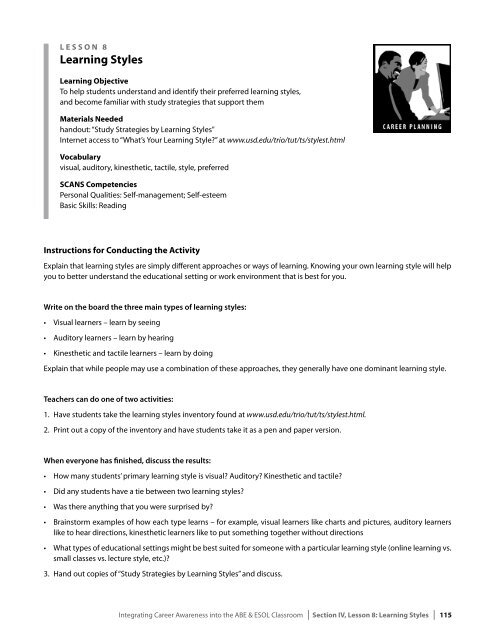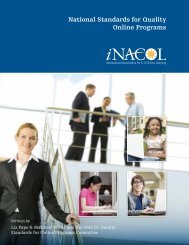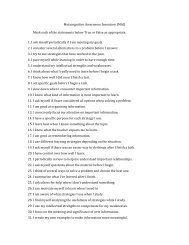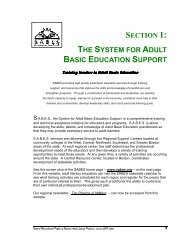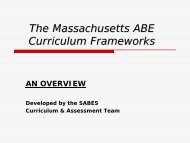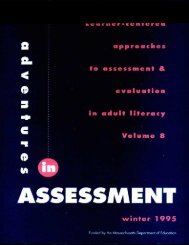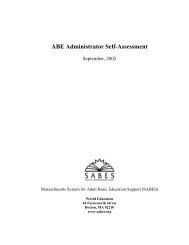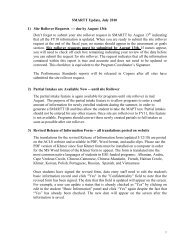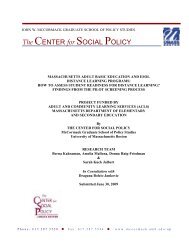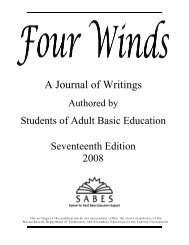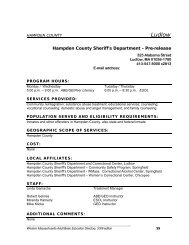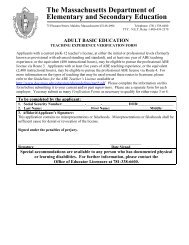Integrating Career Awareness into the ABE/ESOL Classroom - SABES
Integrating Career Awareness into the ABE/ESOL Classroom - SABES
Integrating Career Awareness into the ABE/ESOL Classroom - SABES
- No tags were found...
Create successful ePaper yourself
Turn your PDF publications into a flip-book with our unique Google optimized e-Paper software.
L e s s o n 8<br />
Learning Styles<br />
Learning Objective<br />
To help students understand and identify <strong>the</strong>ir preferred learning styles,<br />
and become familiar with study strategies that support <strong>the</strong>m<br />
Materials Needed<br />
handout: “Study Strategies by Learning Styles”<br />
Internet access to “What’s Your Learning Style?” at www.usd.edu/trio/tut/ts/stylest.html<br />
Vocabulary<br />
visual, auditory, kines<strong>the</strong>tic, tactile, style, preferred<br />
SCANS Competencies<br />
Personal Qualities: Self-management; Self-esteem<br />
Basic Skills: Reading<br />
Instructions for Conducting <strong>the</strong> Activity<br />
Explain that learning styles are simply different approaches or ways of learning. Knowing your own learning style will help<br />
you to better understand <strong>the</strong> educational setting or work environment that is best for you.<br />
Write on <strong>the</strong> board <strong>the</strong> three main types of learning styles:<br />
• Visual learners – learn by seeing<br />
• Auditory learners – learn by hearing<br />
• Kines<strong>the</strong>tic and tactile learners – learn by doing<br />
Explain that while people may use a combination of <strong>the</strong>se approaches, <strong>the</strong>y generally have one dominant learning style.<br />
Teachers can do one of two activities:<br />
1. Have students take <strong>the</strong> learning styles inventory found at www.usd.edu/trio/tut/ts/stylest.html.<br />
2. Print out a copy of <strong>the</strong> inventory and have students take it as a pen and paper version.<br />
When everyone has finished, discuss <strong>the</strong> results:<br />
• How many students’ primary learning style is visual? Auditory? Kines<strong>the</strong>tic and tactile?<br />
• Did any students have a tie between two learning styles?<br />
• Was <strong>the</strong>re anything that you were surprised by?<br />
• Brainstorm examples of how each type learns – for example, visual learners like charts and pictures, auditory learners<br />
like to hear directions, kines<strong>the</strong>tic learners like to put something toge<strong>the</strong>r without directions<br />
• What types of educational settings might be best suited for someone with a particular learning style (online learning vs.<br />
small classes vs. lecture style, etc.)?<br />
3. Hand out copies of “Study Strategies by Learning Styles” and discuss.<br />
<strong>Integrating</strong> <strong>Career</strong> <strong>Awareness</strong> <strong>into</strong> <strong>the</strong> <strong>ABE</strong> & <strong>ESOL</strong> <strong>Classroom</strong> | Section IV, Lesson 8: Learning Styles | 115


